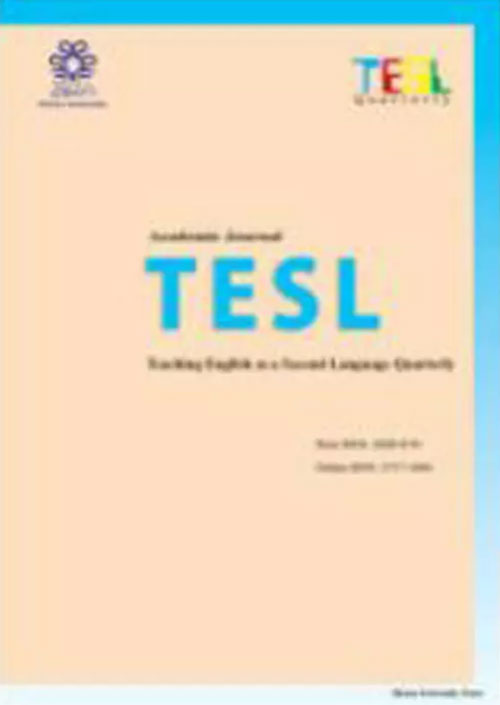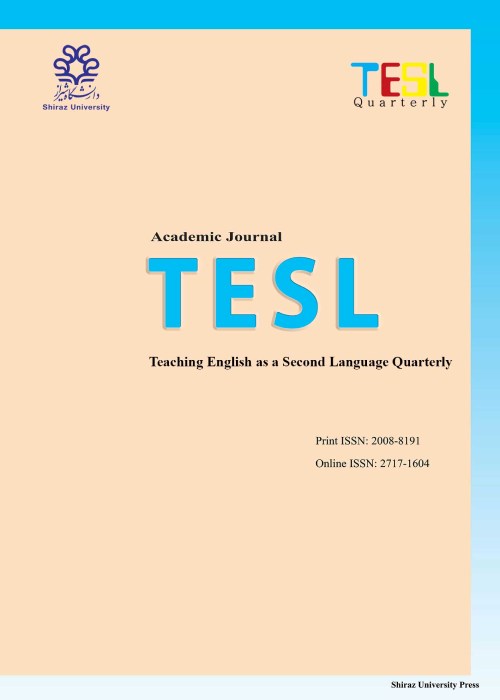فهرست مطالب

Teaching English as a Second Language Quarterly
Volume:41 Issue: 3, Summer 2022
- تاریخ انتشار: 1401/06/09
- تعداد عناوین: 6
-
-
Pages 1-25
This study was designed to highlight the potential effects of different types of Explicit Syntactic Markers (ESMs) on the sentence comprehension of EFL learners of different age-range and proficiency levels. Consequently, two hundred and forty beginners, intermediate, and advanced Iranian EFL learners were selectedfrom an initial pool of six hundred and sixty learners. They were selected based on their McMillan Placement Test (MPT) performance. Subsequently, they were categorized into two age groups teenagers and adults. An online software application (Com-Chron) was utilized to provide learners with a set of ESM and non-ESM English sentences on the screen to measure the accurate comprehension and the elapsed time needed for the perception of the presented sentences. Data analyses revealed that participants had a significantly superior performance for comprehending the ESM items (though they were longer sentences than non-ESM items). Furthermore, it was revealed that proficiency level, unlike age, caused a statistically significant difference in comprehending the ESM sentences. It was also concluded that different types of explicit syntactic markers imposed different degrees of comprehension difficulty both in terms of accuracy and the needed time for the participants’ comprehension; sentences with punctuation marks and conjunctions were the easiest for the participants, while those including determiners and link breaks were the most challenging. Results also indicated that all the ESMs (except for the link breaks) can significantly account for English sentence comprehension and can be assumed as comprehension predictors to various degrees.
Keywords: English sentence comprehension, Explicit syntactic markers (ESMs), Comprehension difficulty, Comprehension time, accuracy -
Pages 27-55
Flow, introduced as one of the founding concepts in positive psychology by Csikszentmihalyi (1990), refers to the complete absorption in a challenging mental, emotional, or physical task to the exclusion of attention to any other surrounding thing. Since the Covid-19 pandemic, whole aspects of human life have changed, and language learning is no exception. The present study explored various obstacles in experiencing flow among Iranian EFL learners while completing tasks in three different modalities: face-to-face (F2F), text-based, and audio-based interaction during the Covid-19 pandemic. The data were elicited from 55 upper-intermediate learners divided into three groups completing the tasks in pairs, each through one of the three modalities, as a part of their classroom activity. Immediately following class time, they were interviewed individually or through group chats via WhatsApp. Under the three different modalities, the qualitative content analysis identified obstacles in achieving flow and categorized them into five themes. The results revealed that the main barriers in the face-to-face group were related to contextual or environmental factors as well as to task-induced issues. However, technological, task-based, and teacher-related factors gained higher percentages among text-based and audio-based interaction themes. The findings offer insight into flow perception by second language learners in different task modalities during the Covid-19 pandemic.
Keywords: flow barriers, task modality, The Covid-19 Pandemic -
Pages 57-87
Learning-oriented assessment (LOA) seeks to support instruction by providing information about students’ current learning conditions and their ultimate performance. This study scrutinizes the application of LOA in English as a Foreign Language (EFL) writing classes within Iranian language institutes. In addition, the current study examined the participants’ writing traits using the researchers-developed writing traits questionnaire during the implementation of LOA. Sixty upper-intermediate students (male & female) in two intact classes at a language institute in Tabriz, Iran, were taken as the participants. One of these classes was randomly picked as the control and the other one as the experimental group. During the treatment, learners of the experimental group carried out the relevant writing tasks based on the principles of LOA. On the other hand, the control group adopted the teacher-centered approach. 120 IELTS writing task 2 samples were collected and scored by using a scoring rubric (Wang & Liao, 2008) before and after the LOA treatment. To realize the differences in the mean scores of students in the control group and the experimental group, an independent sample t-test was used. The findings showed that the students of the experimental group benefited vastly from multiple drafting, self, and peer-evaluation, sharing learning goals with teachers and each other, and using feedforward techniques instead of feedback. The results might provide both theory and pedagogy implications for syllabus designers and language teachers with valuable guidelines on improving writing assessment in IELTS writing courses.
Keywords: Alternative Assessment, Feed-Forward Technique, Formative Feedback, IELTS Writing, Learning-Oriented Assessment -
Pages 89-115
This mixed-methods study sought to examine any significant impact of Iranian English as a Foreign Language (EFL) teachers' collaboration in rating speaking tests and brainstorming theoretical concepts of language assessment (LA) on their literacy, perceptions, and practices of speaking assessment. Forty-one Iranian EFL teachers selected through purposeful sampling were asked to fill out a questionnaire, including 20 components of LA, so as to measure their knowledge and perceptions of LA components. Then, 21 of the teachers volunteered to score the video-projected speaking performance of 12 international students in the Key English Test (KET) using KET speaking rating scales. Having received six sessions of in-service speaking assessment training based on their collaboration, the 21 participating teachers completed the same questionnaire and scored the same videos again. An ANCOVA was used to compare the quantitative data from the questionnaire and teachers’ scoring of KET speaking tests before and after the treatment, and also to investigate any significant differences between the novice and experienced Iranian EFL teachers in terms of their knowledge and perception of LA, and the assessment of KET speaking tests. Moreover, the 21 volunteered teachers were interviewed to further discover their perceptions about the in-service speaking assessment training course they attended. The findings revealed that the collaboration of the Iranian EFL teachers in rating speaking tests and brainstorming theoretical concepts of LA had a significant impact on their knowledge, perceptions, and practices of LA, though the effects were unequal and different for the novice and experienced EFL teachers.
Keywords: Teacher collaboration, Language assessment literacy, in-service EFL teachers, speaking assessment training, teaching experience -
Pages 117-153
Since an effective technique to assess the level of thinking ability is to identify the types of questions one generates, the present research by employing a hybrid question framework, intended to investigate the status of thinking ability among Iranian EFL students in two majors of TEFL and English Literature in M.A. and Ph.D. degrees. To this end, through convenience sampling, a group of 51 students were asked to read two simple short texts and make any type of question(s) that would spring to their mind in essay-type format. Then, using purposeful sampling, 15 participants out of 51 were selected for a semi-structured interview. The findings revealed that nearly half of the participants were not able to generate thought-provoking questions. This point may denote that beyond-routine thinking is not welcomed in the related context. Moreover, as the English Literature students were more capable of producing thought-provoking questions than the TEFL students, it can be inferred that academic major can be considered as an essential factor impacting one’s way of thinking. Furthermore, since the students of English Literature/TEFL in Ph.D. degree outperformed those in M.A. degree, it can be concluded that the academic degree can be accounted as an aiding factor influencing the level of thinking ability as well. Furthermore, in searching for the reasons affecting (non-) production of thought-provoking questions, several factors were discovered and categorized into impeding and promoting ones.
Keywords: Creative thinking, critical thinking, EFL, philosophical thinking, reflective thinking -
Pages 155-195
Collaborative dialogue (CD) in developing L2 skills known as ‘knowledge-building dialogue’, in spite of its momentum in foreign language acquisition, has rarely been conjoined and empirically investigated with a Task-based approach. To this end, the present research was conducted with a two-fold aim firstly, investigating the effect of task-based collaborative dialogue on English as a foreign language (EFL) learners’ speaking ability, and secondly, exploring teachers’ and learners’ perceptions of the exercised treatment process. The participants of the study consisted of 100 Iranian B.A. TEFL and Translation Studies students were identified as relatively homogeneous with regard to their language proficiency through administering Oxford Placement Test (OPT) and ten Iranian EFL teachers. The experimental group was exposed to task-based collaborative dialogues, while the control group experienced conventional mainstream teaching the speaking skill. Upon completing the treatment, CD questionnaires were administered to the experimental group of learners and teachers to investigate their perceptions of implementing CDs in speaking classes. Subsequently, the teachers and 12 students from the experimental group attended the semi-structured interview sessions to explore their views regarding the efficiency of task-based CDs. The findings indicated that the experimental group outperformed the control one regarding speaking skill. The results of the questionnaires and the semi-structured interviews complemented each other and indicated that the teachers and the learners adopted positive views toward applying the task-based CD. The findings offer some implications for the stakeholders, including material developers, EFL learners, and teachers, to incorporate task-based collaborative dialogues in second language education.
Keywords: Collaborative dialogue, Speaking Skill, task-based language teaching


